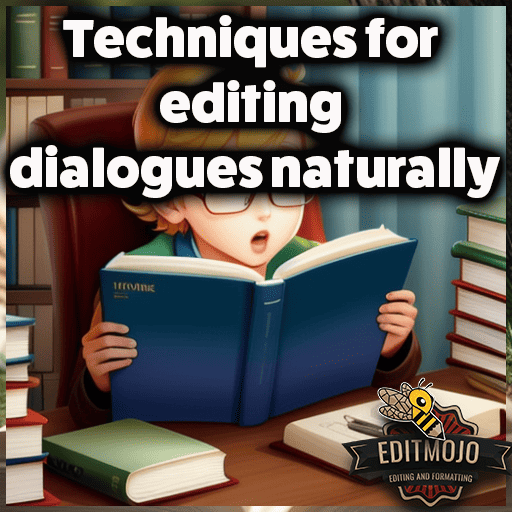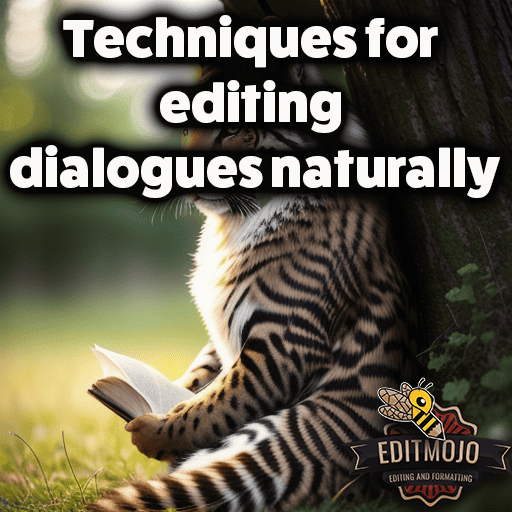Techniques for editing dialogues naturally
Techniques for editing dialogues naturally. Dialogue is the lifeblood of narrative. It breathes energy into characters, propels the plot forward, and lends authenticity to a writer’s world. It has the power to bring readers closer to your characters’ thoughts and emotions, making them an integral part of the storytelling process. However, crafting natural and believable dialogue can be challenging for even the most experienced writers, which is why understanding and mastering the techniques for editing dialogue is crucial.
Key Takeaways
| Section | Key Takeaways |
|---|---|
| Understanding Dialogue | Real-life conversations influence fictional dialogue, but it’s more purposeful and dramatic. The dialogue serves to reveal character, advance the plot, and provide context. |
| Pre-editing Considerations | Understand your characters and their speech patterns. Consider the scene’s context and setting, and remember the role of subtext in dialogue. |
| Techniques for Editing Dialogue | Techniques include pruning unnecessary filler words, breaking up monologues, using dialogue tags sparingly, using action beats, and varying speech patterns among characters. |
| Advanced Editing Techniques | Edit for subtext, maintain consistency in character voice, use dialogue to show character development, and create tension through dialogue. |
| Dialogue Editing in Different Genres | The genre influences the dialogue editing process. In realistic fiction, it should reflect the characters’ backgrounds. In fantasy or sci-fi, it aids in world-building. In thrillers and mysteries, it maintains suspense and reveals clues. |
| Tools and Resources for Dialogue Editing | There are numerous resources available, from editing software like ProWritingAid or Grammarly, to online courses and writer’s communities. |
Understanding Dialogue
How Real-life Conversations Influence Fictional Dialogue
Dialogue in fiction mimics real-life conversations, but it’s not a verbatim transcript. It’s more condensed, purposeful, and dramatic. Real-life conversations can often be repetitive and aimless, but fictional dialogue must always serve a purpose – either to reveal character traits, advance the plot, or provide essential background information. Understanding this difference is the first step in crafting and editing natural dialogue.

The Purpose of Dialogue in a Story
Dialogue does more than just fill up blank pages. It reveals character, advances the plot, and provides context for the reader. It allows characters to interact, disagree, make peace, and show their true colors. Above all, dialogue gives a voice to your characters, making them more relatable and realistic to readers.
Common Mistakes in Writing Dialogue
One common pitfall in writing dialogue is making all characters sound alike. Everyone has unique speech patterns and vocabulary, and characters should be no different. Another common mistake is overusing dialogue tags. These can often become distracting and lead to monotonous reading. Understanding these mistakes can help guide your dialogue editing process.
Pre-editing Considerations
Knowing your Characters: Speech Patterns and Vocabulary
Before diving into dialogue editing, take time to understand your characters thoroughly. What are their educational backgrounds, interests, and personalities like? How would they naturally express themselves? Mapping out your character’s unique voice will add depth and realism to their dialogue.
Context and Setting: How it Influences Dialogue
The context and setting of a scene heavily influence the dialogue. A conversation in a bustling market will be different from one in a quiet library. The dialogue should reflect the environment, adding layers to the scene’s realism and mood.
The Role of Subtext in Dialogue
Subtext is what’s left unsaid but understood in a conversation. It’s an essential tool in creating tension, developing relationships, and revealing character traits. To master subtext, one must learn to read between the lines and infer meaning from what isn’t said explicitly.
Techniques for Editing Dialogue
Pruning Unnecessary Filler Words
While filler words can add authenticity to dialogue, too many can make it sound stilted or inauthentic. Editing involves pruning unnecessary fillers while retaining those that give the dialogue a natural rhythm. The key is to strike a balance.

Breaking Up Monologues: Maintaining a Natural Pace
Real conversations are dynamic and interactive. If a character is delivering a long monologue, consider breaking it up with reactions or interjections from other characters. This adds to the realism and maintains reader engagement.
Dialogue Tags: Their Use and Misuse
Dialogue tags like ‘said’, ‘asked’, and ‘replied’ are essential to attribute dialogue but should be used sparingly and efficiently. Overuse can lead to repetitive reading, while underuse
can create confusion about who’s speaking. A good rule of thumb is to use tags when necessary for clarity, but otherwise, let the dialogue and action carry the conversation.
Using Action Beats to Enhance Dialogue
Action beats are a useful tool to break up dialogue and provide visual cues to the reader. They can help convey a character’s mood or reaction without explicitly stating it. For example, instead of writing, “I’m not sure,” she said hesitantly, you could write, “I’m not sure,” she said, twisting her ring.
The Role of Punctuation in Conveying Tone and Emotion
Punctuation marks are the unsung heroes of dialogue editing. They can subtly change the tone and pace of a conversation. A question mark can denote surprise or uncertainty, an exclamation point can express excitement or anger, and ellipses can indicate hesitation or suspense.
Varying Speech Patterns among Characters
Characters should have distinct voices. This can be achieved by varying their speech patterns, vocabulary, and sentence structures. It gives each character a unique voice, making them more memorable to the reader.
Advanced Editing Techniques
Subtext Editing: How to Imply More Than What is Said
Subtext editing involves carefully choosing words and phrases that hint at underlying emotions or conflicts. It requires a deep understanding of your characters and their motivations.

Maintaining Consistency in Character Voice
Consistency in character voice is essential for credibility. A character’s voice should remain consistent throughout the story unless there’s a valid reason for it to change (like character development or a dramatic event).
Using Dialogue to Show Character Development
Dialogue can be a powerful tool for showing character development. By subtly changing a character’s dialogue over time, you can show how they grow, change, and adapt to their circumstances.
Creating and Maintaining Tension through Dialogue
Tension is a crucial element in any story, and dialogue is an effective tool to create and sustain it. Conflict, disagreements, secrets, and unexpressed feelings can all add tension to a conversation.
Dialogue Editing in Different Genres
Dialogue Editing for Realistic Fiction
In realistic fiction, dialogue should reflect the characters’ socio-economic background, education level, and geographic location. Regional dialects, local slang, and specific jargon can add authenticity to the dialogue.
Dialogue Editing for Science Fiction and Fantasy
In science fiction and fantasy, dialogue plays a crucial role in world-building. While it should still sound natural, it can also include unique phrases or languages that fit the world of the story.
Dialogue Editing for Thrillers and Mysteries
In thrillers and mysteries, dialogue often serves to maintain suspense and reveal clues. Precision and ambiguity are vital, keeping readers guessing without misleading them.
Tools and Resources for Dialogue Editing
There are many resources available to help with dialogue editing. Software like ProWritingAid or Grammarly can help with technical aspects like punctuation and grammar. For feedback and advice, consider joining writers’ groups, attending workshops, or enrolling in online courses like those offered by MasterClass or Coursera.
Conclusion (Techniques for editing dialogues naturally)
Writing and editing dialogue is a skill that improves with practice. Keep in mind the unique voice of each character, consider the context of the conversation, and remember the importance of subtext. With these techniques, your dialogues can become more natural, engaging, and meaningful.
Additional Resources and Further Reading
For further reading, consider books like “Dialogue” by Robert McKee or “How to Write Dazzling Dialogue” by James Scott Bell. Websites like Writer’s Digest also offer useful articles and tips on dialogue writing and editing. Happy writing!
Top Five Q&As on Techniques for Editing Dialogues Naturally
Q1: Why is editing dialogue important in a story?
A1: Editing dialogue is important as it helps make conversations more natural, engaging, and relevant to the plot or character development. It can also enhance the pacing of the story and the reader’s connection to the characters.
Q2: What are some common mistakes in writing dialogue?
A2: Common mistakes include making all characters sound alike, overusing dialogue tags, using unnecessary filler words, and not considering the role of context and setting.
Q3: How can I make the dialogue of each character unique?
A3: You can make each character’s dialogue unique by considering their background, interests, and personality when crafting their speech patterns and vocabulary. Varying these aspects among characters can help give each a distinctive voice.
Q4: How can I create tension through dialogue?
A4: You can create tension through dialogue by employing subtext, introducing conflicts or disagreements, and having characters withhold information or express unspoken feelings.
Q5: Are there any tools or resources that can aid in dialogue editing?
A5: Yes, there are various resources like editing software (ProWritingAid, Grammarly), online courses (MasterClass, Coursera), and writer’s communities where you can get feedback and advice on your dialogue.
